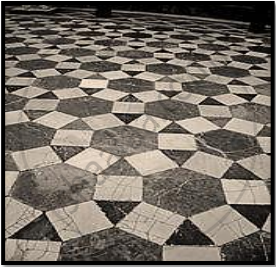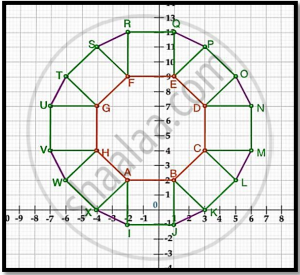Advertisements
Advertisements
Question
Show that the following points are the vertices of a rectangle.
A (2, -2), B(14,10), C(11,13) and D(-1,1)
Solution
The given points are A (2, -2), B(14,10), C(11,13) and D(-1,1).
`AB = sqrt((14-2)^2 +{10-(-2)}^2) = sqrt((12)^2 +(12)^2) =sqrt(144+144) = sqrt(288) =12 sqrt(2) units`
`BC = sqrt(( 11-14)^2 +(13-10)^2 ) = sqrt((-3)^2 +(3)^2) = sqrt(9+9) = sqrt(18) = 3 sqrt(2) units`
` CD = sqrt((-1-11)^2 +(1-13)^2) = sqrt((-12)^2 +(-12)^2) = sqrt(144+144) = sqrt(288) = 12 sqrt(2) units`
`AD = sqrt((-1-2)^2 +{1-(-2)}^2) = sqrt((-3)^2 +(3)^2) = sqrt(9+9) = sqrt(18) =3 sqrt(2) units`
`Thus AB =CD = 12 sqrt(2) "units and " BC =AD = 3 sqrt(2) units`
Also ,
`AC = sqrt((11-2)^2 +{ 13-(-2)}^2) = sqrt((9)^2 +(15)^2) = sqrt(81+225) = sqrt(306) = 3 sqrt(34) units `
` BD = sqrt((-1-14)^2 +(1-10)^2) = sqrt((-15)^2 +(-9)^2) = sqrt(81+225) = sqrt(306) =3 sqrt(34) units`
Also, diagonal AC = diagonal BD
Hence, the given points from a rectangle
APPEARS IN
RELATED QUESTIONS
If A(–2, 1), B(a, 0), C(4, b) and D(1, 2) are the vertices of a parallelogram ABCD, find the values of a and b. Hence find the lengths of its sides
Let ABCD be a square of side 2a. Find the coordinates of the vertices of this square when The centre of the square is at the origin and coordinate axes are parallel to the sides AB and AD respectively.
In the seating arrangement of desks in a classroom three students Rohini, Sandhya and Bina are seated at A(3, 1), B(6, 4), and C(8, 6). Do you think they are seated in a line?
Determine the ratio in which the straight line x - y - 2 = 0 divides the line segment
joining (3, -1) and (8, 9).
Find the ratio in which the line segment joining (-2, -3) and (5, 6) is divided by x-axis Also, find the coordinates of the point of division in each case.
If the points A (a, -11), B (5, b), C (2, 15) and D (1, 1) are the vertices of a parallelogram ABCD, find the values of a and b.
Point A lies on the line segment PQ joining P(6, -6) and Q(-4, -1) in such a way that `(PA)/( PQ)=2/5` . If that point A also lies on the line 3x + k( y + 1 ) = 0, find the value of k.
ABCD is a rectangle whose three vertices are A(4,0), C(4,3) and D(0,3). Find the length of one its diagonal.
Find the ratio in which the point (−3, k) divides the line-segment joining the points (−5, −4) and (−2, 3). Also find the value of k ?
Show that `square` ABCD formed by the vertices A(-4,-7), B(-1,2), C(8,5) and D(5,-4) is a rhombus.
Show that ΔABC, where A(–2, 0), B(2, 0), C(0, 2) and ΔPQR where P(–4, 0), Q(4, 0), R(0, 2) are similar triangles.
Write the distance between the points A (10 cos θ, 0) and B (0, 10 sin θ).
Write the formula for the area of the triangle having its vertices at (x1, y1), (x2, y2) and (x3, y3).
The distance between the points (cos θ, 0) and (sin θ − cos θ) is
If the distance between the points (4, p) and (1, 0) is 5, then p =
A line segment is of length 10 units. If the coordinates of its one end are (2, −3) and the abscissa of the other end is 10, then its ordinate is
If the line segment joining the points (3, −4), and (1, 2) is trisected at points P (a, −2) and Q \[\left( \frac{5}{3}, b \right)\] , Then,
Find the point on the y-axis which is equidistant from the points (5, −2) and (−3, 2).
The line 3x + y – 9 = 0 divides the line joining the points (1, 3) and (2, 7) internally in the ratio ______.
A tiling or tessellation of a flat surface is the covering of a plane using one or more geometric shapes, called tiles, with no overlaps and no gaps. Historically, tessellations were used in ancient Rome and in Islamic art. You may find tessellation patterns on floors, walls, paintings etc. Shown below is a tiled floor in the archaeological Museum of Seville, made using squares, triangles and hexagons.

A craftsman thought of making a floor pattern after being inspired by the above design. To ensure accuracy in his work, he made the pattern on the Cartesian plane. He used regular octagons, squares and triangles for his floor tessellation pattern

Use the above figure to answer the questions that follow:
- What is the length of the line segment joining points B and F?
- The centre ‘Z’ of the figure will be the point of intersection of the diagonals of quadrilateral WXOP. Then what are the coordinates of Z?
- What are the coordinates of the point on y-axis equidistant from A and G?
OR
What is the area of Trapezium AFGH?
